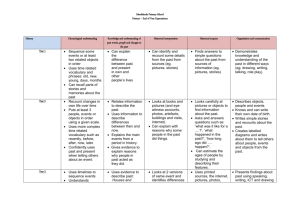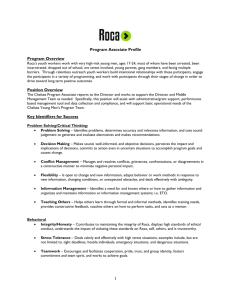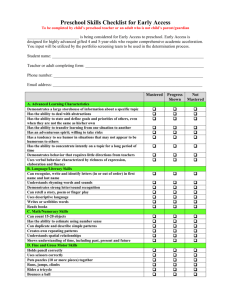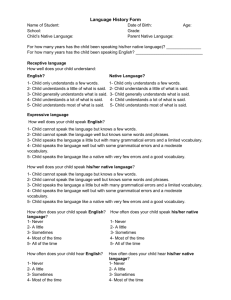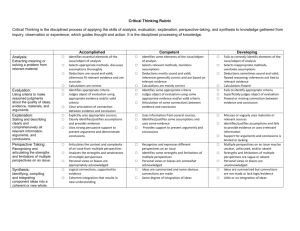Appendix One
advertisement
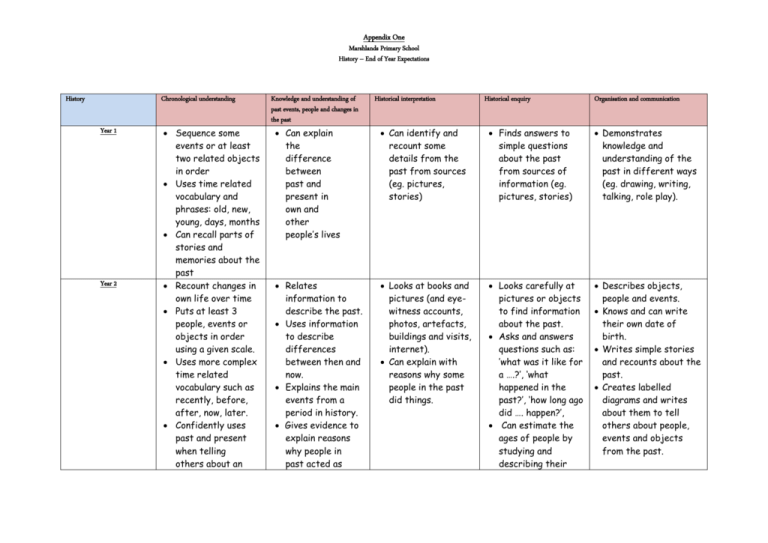
Appendix One Marshlands Primary School History – End of Year Expectations History Chronological understanding Year 1 Year 2 Sequence some events or at least two related objects in order Uses time related vocabulary and phrases: old, new, young, days, months Can recall parts of stories and memories about the past Recount changes in own life over time Puts at least 3 people, events or objects in order using a given scale. Uses more complex time related vocabulary such as recently, before, after, now, later. Confidently uses past and present when telling others about an Knowledge and understanding of past events, people and changes in the past Historical interpretation Historical enquiry Organisation and communication Can explain the difference between past and present in own and other people’s lives Can identify and recount some details from the past from sources (eg. pictures, stories) Finds answers to simple questions about the past from sources of information (eg. pictures, stories) Demonstrates knowledge and understanding of the past in different ways (eg. drawing, writing, talking, role play). Relates information to describe the past. Uses information to describe differences between then and now. Explains the main events from a period in history. Gives evidence to explain reasons why people in past acted as Looks at books and pictures (and eyewitness accounts, photos, artefacts, buildings and visits, internet). Can explain with reasons why some people in the past did things. Looks carefully at pictures or objects to find information about the past. Asks and answers questions such as: ’what was it like for a ….?’, ‘what happened in the past?’, ‘how long ago did …. happen?’, Can estimate the ages of people by studying and describing their Describes objects, people and events. Knows and can write their own date of birth. Writes simple stories and recounts about the past. Creates labelled diagrams and writes about them to tell others about people, events and objects from the past. Appendix One Marshlands Primary School History – End of Year Expectations Year 3 event. Uses timelines to sequence events Understands timeline can be divided into BC and AD. Confidently applies time related vocabulary: century, decade. they did. Uses evidence to describe past: Houses and settlements Culture and leisure activities, clothes, way of life and actions of people, buildings and their uses, people’s beliefs and attitudes, things of importance to people, differences between lives of rich and poor Applies evidence to find out how any of these may have changed during a time period. Describes similarities and differences between people, events and objects Looks at 2 versions of same event and identifies differences in the accounts. features. Uses printed sources, the internet, pictures, photos, music, artefacts, historic buildings and visits to collect information about the past. Asks questions such as ‘how did people ….? What did people do for ….?’ Suggests sources of evidence to use to help answer questions Presents findings about past using speaking, writing, ICT and drawing skills Uses dates and terms with increasing accuracy. Discusses different ways of presenting information for different purposes. Appendix One Marshlands Primary School History – End of Year Expectations Year4 Uses words and phrases: century, decade, BC, AD, after, before, during. Divides recent history into present, using 21st century, and the past using 19th and 20th centuries. Names and places dates of significant events from past on a timeline. Demonstrates changes on a timeline Shows knowledge and understanding by describing features of past societies and periods. Identifies some ideas, beliefs, attitudes and experiences of men, women and children from the past. Gives reasons why changes in houses, culture, leisure, clothes, buildings and their uses, things of importance to people, ways of life, beliefs and attitudes may have occurred during a time period. Describes how some of the past events/people Understands and gives reasons why there may be different accounts of history. Knows the difference between primary and secondary sources of evidence. Understands the need for evidence and uses documents, printed sources, the internet, databases, pictures, photos, music, artefacts, historic buildings and visits to collect information about the past. Asks questions such as ‘what was it like for a …… during ……?’ Suggests sources of evidence from a selection provided to use to help answer questions. Presents findings about past using speaking, writing, maths (data handling), ICT, drama and drawing skills Accurately uses dates and historical terms. Discusses most appropriate way to present information, considering the audience. Understands and applies subject specific words such as settlement, invader, monarch Appendix One Marshlands Primary School History – End of Year Expectations affect life today. Year 5 Year 6 Can use timelines to place and sequence local, national and international events. Sequences historical periods. Describes events using historical vocabulary: century, decade, BC, AD, after, before, during, Tudors, Stuarts, Victorians, era, period. Identifies and explains changes within and across historical periods. Identifies some social, cultural, religious and ethnic diversities of societies studied in Britain and wider world. Can explain the causes and consequences of the main events, situations and changes in the periods studied. Identifies changes and links within and across the time periods studied. Understands and explores different versions of the same event and identifies differences in the accounts. Can justify why there may be different accounts of history. Understands that people (currently and historically) represent events or ideas in ways that persuade others Confidently uses documents, printed sources, the internet, databases, pictures, photos, music, artefacts, historic buildings and visits to collect information about the past. Asks a range of questions about the past. Selects reliable sources of evidence to answer questions. Understands and can explain that there is often not a single answer to historical questions. Creates structured presentations and organised findings about the past using speaking, writing, maths, ICT, drama and drawing skills. Applies and uses dates and historical terms accurately. Selects and justifies most appropriate way to present information to an audience Uses timelines to place events, periods and cultural movements from around the world. Uses timelines to Identifies and selects reliable sources of factual evidence to describe: houses and settlements; Understands that the past has been represented in different ways. Draws conclusions and provides Identifies and uses different sources of information and artefacts. Evaluates and gives reasons for the Presents information systematically with clear structure. Selects and uses a range of presenting methods Appendix One Marshlands Primary School History – End of Year Expectations demonstrate changes and developments in culture, technology, religion and society. Understands and uses key periods as reference points: BC, AD Romans, Anglo-Saxons, Tudors, Stuarts, Georgians, Victorians and Today. Describes main changes in a period in history using historical vocabulary such as: social, religious, political, technological and cultural. Recalls accurately the date of any significant event studied from past and can order it chronologically culture and leisure activities; clothes, way of life and actions of people; buildings and their uses; people’s beliefs, religion and attitudes; things of importance to people; differences between lives of rich and poor. Can explain how any of above may have changed during a time period. Draws conclusions and provides own reasons why changes may have occurred, backed up with evidence. Shows identified changes on a timeline. Identifies and articulates similarities and differences accurate and plausible reasons for how/why aspects of the past have been represented and interpreted in different ways. Understands and explains that some evidence is propaganda, opinion or misinformation and that this affects interpretations of history. usefulness and accuracy of different sources of evidence. Selects the most appropriate source of evidence for particular tasks and justifies choice. Can explain own opinions about historical events using evidence from a range of sources. Presents information in the most appropriate way (eg written explanation/tables and charts/labelled diagram) and justifies choices. Uses specific dates and historical terms accurately. Appendix One Marshlands Primary School History – End of Year Expectations between some people, events and objects studied. Understands and describes how some changes affect life today. Makes links between features of past societies.
